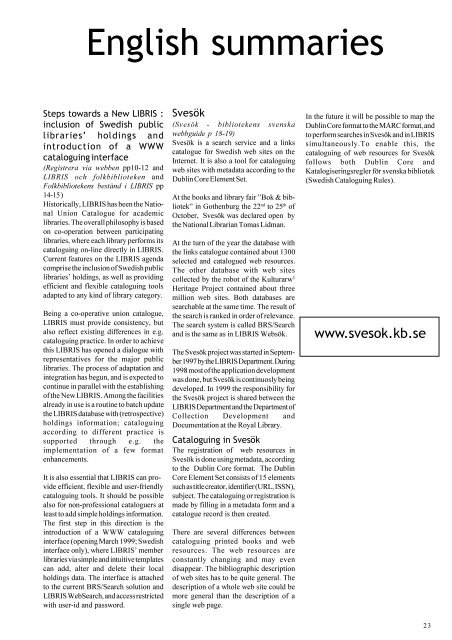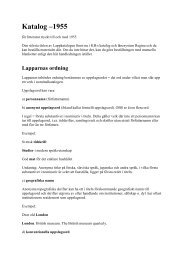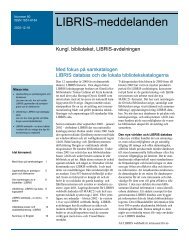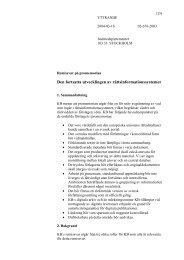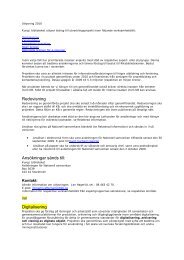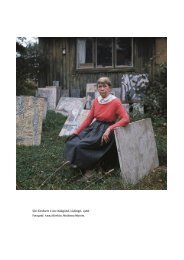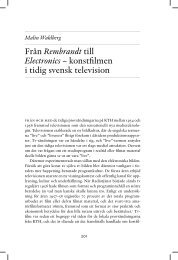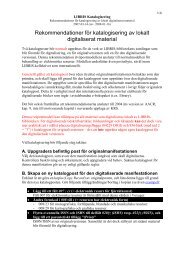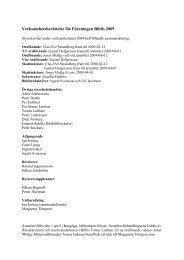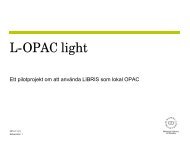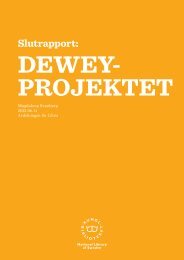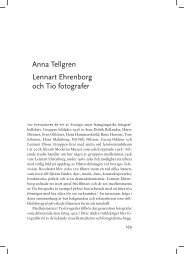Librismeddelanden-79
Librismeddelanden-79
Librismeddelanden-79
Create successful ePaper yourself
Turn your PDF publications into a flip-book with our unique Google optimized e-Paper software.
English summaries<br />
Steps towards a New LIBRIS :<br />
inclusion of Swedish public<br />
libraries’ holdings and<br />
introduction of a WWW<br />
cataloguing interface<br />
(Registrera via webben pp10-12 and<br />
LIBRIS och folkbiblioteken and<br />
Folkbibliotekens bestånd i LIBRIS pp<br />
14-15 )<br />
Historically, LIBRIS has been the National<br />
Union Catalogue for academic<br />
libraries. The overall philosophy is based<br />
on co-operation between participating<br />
libraries, where each library performs its<br />
cataloguing on-line directly in LIBRIS.<br />
Current features on the LIBRIS agenda<br />
comprise the inclusion of Swedish public<br />
libraries’ holdings, as well as providing<br />
efficient and flexible cataloguing tools<br />
adapted to any kind of library category.<br />
Being a co-operative union catalogue,<br />
LIBRIS must provide consistency, but<br />
also reflect existing differences in e.g.<br />
cataloguing practice. In order to achieve<br />
this LIBRIS has opened a dialogue with<br />
representatives for the major public<br />
libraries. The process of adaptation and<br />
integration has begun, and is expected to<br />
continue in parallel with the establishing<br />
of the New LIBRIS. Among the facilities<br />
already in use is a routine to batch update<br />
the LIBRIS database with (retrospective)<br />
holdings information; cataloguing<br />
according to different practice is<br />
supported through e.g. the<br />
implementation of a few format<br />
enhancements.<br />
It is also essential that LIBRIS can provide<br />
efficient, flexible and user-friendly<br />
cataloguing tools. It should be possible<br />
also for non-professional cataloguers at<br />
least to add simple holdings information.<br />
The first step in this direction is the<br />
introduction of a WWW cataloguing<br />
interface (opening March 1999; Swedish<br />
interface only), where LIBRIS’ member<br />
libraries via simple and intuitive templates<br />
can add, alter and delete their local<br />
holdings data. The interface is attached<br />
to the current BRS/Search solution and<br />
LIBRIS WebSearch, and access restricted<br />
with user-id and password.<br />
Svesök<br />
(Svesök - bibliotekens svenska<br />
webbguide p 18-19)<br />
Svesök is a search service and a links<br />
catalogue for Swedish web sites on the<br />
Internet. It is also a tool for cataloguing<br />
web sites with metadata according to the<br />
Dublin Core Element Set.<br />
At the books and library fair ”Bok & bibliotek”<br />
in Gothenburg the 22 nd to 25 th of<br />
October, Svesök was declared open by<br />
the National Librarian Tomas Lidman.<br />
At the turn of the year the database with<br />
the links catalogue contained about 1300<br />
selected and catalogued web resources.<br />
The other database with web sites<br />
collected by the robot of the Kulturarw 3<br />
Heritage Project contained about three<br />
million web sites. Both databases are<br />
searchable at the same time. The result of<br />
the search is ranked in order of relevance.<br />
The search system is called BRS/Search<br />
and is the same as in LIBRIS Websök.<br />
The Svesök project was started in September<br />
1997 by the LIBRIS Department. During<br />
1998 most of the application development<br />
was done, but Svesök is continuosly being<br />
developed. In 1999 the responsibility for<br />
the Svesök project is shared between the<br />
LIBRIS Department and the Department of<br />
Collection Development and<br />
Documentation at the Royal Library.<br />
Cataloguing in Svesök<br />
The registration of web resources in<br />
Svesök is done using metadata, according<br />
to the Dublin Core format. The Dublin<br />
Core Element Set consists of 15 elements<br />
such as title creator, identifier (URL, ISSN),<br />
subject. The cataloguing or registration is<br />
made by filling in a metadata form and a<br />
catalogue record is then created.<br />
There are several differences between<br />
cataloguing printed books and web<br />
resources. The web resources are<br />
constantly changing and may even<br />
disappear. The bibliographic description<br />
of web sites has to be quite general. The<br />
description of a whole web site could be<br />
more general than the description of a<br />
single web page.<br />
In the future it will be possible to map the<br />
Dublin Core format to the MARC format, and<br />
to perform searches in Svesök and in LIBRIS<br />
simultaneously.To enable this, the<br />
cataloguing of web resources for Svesök<br />
follows both Dublin Core and<br />
Katalogiseringsregler för svenska bibliotek<br />
(Swedish Cataloguing Rules).<br />
www.svesok.kb.se<br />
23


